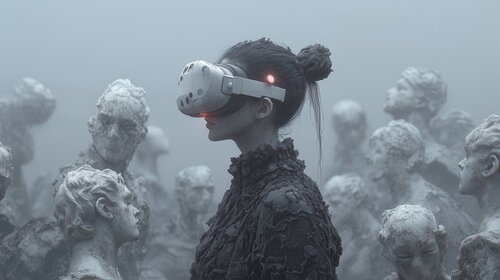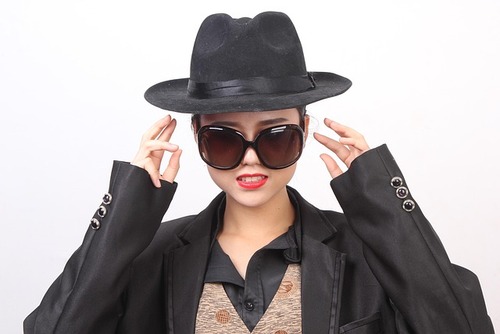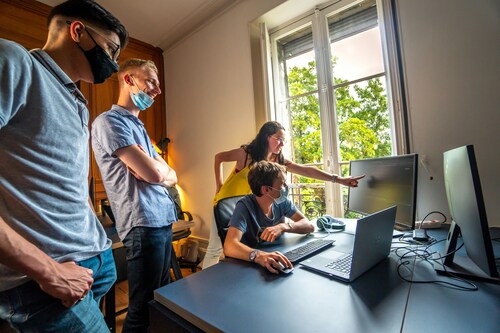
In an era where algorithms structure not only content, but consciousness itself, Hybrid Collapse offers an artistic response from within. Treating algorithmic logic as aesthetic material, the project composes cinematic loops, sonic gestures, and symbolic repetition into a recursive system — where art doesn’t escape the algorithm, but confronts it on its own terms.
Art no longer exists outside the system.
It pulses within the same circuits that deliver your feed, optimize your desire, and predict your next gesture. In this context, Hybrid Collapse does not attempt to escape the algorithm — it enters it, and begins to speak in its language.
This is not art about technology. It is art made from the inside of technological logic — recursive, symbolic, dissonant.
A cinematic system where sound, image, and text operate together as an algorithmic ritual: repetitive, hypnotic, ideologically saturated.
Art as Structural Intervention
In Hybrid Collapse, the artist is no longer a sole creator — but a systems designer, a ritual architect, a signal composer. The artwork is not an object, but a structure. Not a representation, but a semantic environment.
Each video loop, sonic pulse, and theoretical essay is part of a larger recursive form. There are no isolated pieces — only interdependent modules. Sound triggers mood. Mood reflects power. Power is mapped in gesture. Gesture is designed by code. Code is shaped by theory.
This is not a gallery-ready object. It is an ecosystem of meaning.
The Algorithm as Aesthetic Medium
Algorithms don’t only sort data — they structure perception. They decide what rises, what repeats, what disappears.
Hybrid Collapse embraces this logic not passively, but critically. It renders algorithmic behavior visible through:
- Looped motion: repetition as ritual, not efficiency
- Mirror symmetry: echo chambers encoded in form
- Visual recursion: feedback systems turned into gestures
- Sound design: glitch, delay, breath loops — echoes of cognitive prediction
The algorithm here is not a backend function — it is an aesthetic material. It shapes time, space, identity. And the art doesn’t fight it — it aestheticizes the confrontation.
Feminine Iconography and Posthuman Surfaces
The visual world of Hybrid Collapse is populated by feminine-coded bodies — masked, mirrored, stylized, ritualized. But these are not sexualized subjects. They are algorithmic icons: symbols of how identity is reproduced, duplicated, and governed by visual culture.
Latex, symmetry, silence, collapse — these are not aesthetic flourishes, but symbolic codes.
They reflect a world in which intimacy is performative, identity is looped, and beauty is engineered through algorithmic training sets.
The body is no longer expressive. It is synthetic topology.
Gesture, Loop, Breakdown
One of the core principles of the project is the breakdown of narrative into gesture.
There is no story in Hybrid Collapse — only ritual repetition. Bodies move, not toward resolution, but toward saturation.
This reflects the experience of life under algorithmic rhythm:
- Always scrolling
- Always optimizing
- Always repeating what once made sense
But in Hybrid Collapse, this loop is slowed down, rendered visible, and aesthetically charged. The gesture becomes overloaded with symbolic weight — until it fractures, collapses, begins again.
This is not a glitch.
This is gesture as resistance.
Toward a Post-Representational Aesthetic
In the algorithmic age, art that seeks to represent is already behind.
Hybrid Collapse offers something else: an art that thinks structurally, that operates symbolically, and that renders visibility as a political act.
It does not illustrate control — it performs it.
It does not escape the algorithm — it mirrors it until the logic breaks.
It does not predict the future — it haunts the present.
Conclusion: The Artist as Algorithmic Translator
In Hybrid Collapse, the artist becomes a translator between systems:
Between body and data.
Between theory and vision.
Between glitch and myth.
The algorithm is not the enemy.
It is the medium of truth — if we can learn to read it critically, aesthetically, symbolically.
This is not art made with AI.
This is art that speaks algorithm — and distorts it, delays it, deprograms it, until meaning leaks through the cracks.



